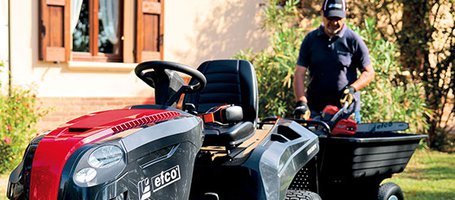How many times have you been left without power, for example due to a mains power outage, or a fault in your household electrical system? Every aspect of our daily lives depends on electricity, which is so taken for granted nowadays that we only realise how essential it is when we don’t have it... fortunately, power generators can save the day.
There are various power generators on the market. We won't say much more here about stationary generators for industrial use, suffice to say that they ensure operational continuity in hospitals and companies, keep construction sites working, provide emergency power in blackouts, and allow sporting events, concerts and festivals to go ahead smoothly. In this article we will give an overview of the uses of portable generators for free time, work needs or in the event of contingencies.
What is a power generator?
A generator basically consists of a petrol-driven internal combustion engine. Combustion causes the pistons inside to move; this movement in turn drives an alternator to generate mechanical energy. The principle of electromagnetic induction converts the mechanical energy into electrical energy, useful for powering various equipment from light bulbs to welding machines. These appliances would otherwise need connecting to the mains network, which here in Italy supplies alternating current at a voltage of 220-230 V for households and 380-400 V for industrial use. A generator provides both alternating current and direct current, in some cases simultaneously (depending on the model). In order for this current to be usable, the generator transforms it to fit the operating parameters of the various equipment.
The beating heart of a power generator is the engine and alternator, but there are also other important components. Let's start with the control features, which are used to operate the generator. They include switches, controls, indicator lights and protection systems (both for the generator and for the connected devices). Also essential are the outlets, which are the sockets that supply the generated power, and which can provide both alternating current and 12 V direct current (cigarette lighter socket, or outlet with positive/negative poles). AC sockets typically deliver single-phase voltage at 230 V, which is the voltage normally used in homes. For example, the Efco PGE 35 DCS, PGE 65 DCS and PGE 65E DCS open-frame power generators deliver 3 to 6 kW of power depending on the model, and have two or three 230 V alternating current sockets and one 12 V direct current socket.
Some generators also supply three-phase alternating current at 400 V, which is an industrial-strength voltage needed to operate high-powered equipment and machinery: one example is the PGE 80E-3 DCS open-frame power generator, which has a 400 V three-phase socket in addition to 230 V single-phase sockets.
Inverter power generators like the Efco PGE 23i S and PGE 48i S can also be equipped with a USB output, which is the rectangular port that enables you to connect smartphones, tablets and so on via a cable with a USB plug.
When and how to use a power generator
What is a power generator used for? To deliver electricity where you need it or when there is no mains supply, and for shorter or longer periods, either occasionally or routinely, or in exceptional situations. Generators are useful for outdoor activities such as camping and garden parties, or when travelling with a motorhome or boat, or when working outdoors (DIY, gardening, etc.). They are essential in places not connected to the mains power grid such as in the countryside, on adventure holidays or at craft markets. If the context calls for low noise emissions, then between open-frame generators and closed-frame generators (which generally includes inverter generators), we recommend the latter, because the engine and alternator are encased in a soundproof enclosure.
Besides domestic and leisure use, you can use your generator for professional applications, such as when working with tools that require high voltages—perhaps in an isolated location or on a construction site that is not yet hooked up to the mains—or if you are a street trader.
In all these examples, generators are the main power source, but you can use them as an auxiliary source in addition to the mains supply. Power generators are also irreplaceable in the event of mains outages or emergency situations.
The equipment that you operate or charge using your generator can be small or large appliances, electronic devices or power tools. At a campsite or garden party, that might include lights, induction hobs for cooking, barbecues, a mini fridges, coffee machines, sound systems, portable air conditioners, e-bikes, e-scooters and so on. Or even televisions, cameras, e-book readers, computers, tablets and games consoles, as well as the ubiquitous smartphone: this type of device is sensitive to voltage fluctuations, so we recommend an inverter generator because they deliver stable, high-quality current.
With a power generator you can also operate electrical gardening tools—from lawnmowers to hedgetrimmers—and charge battery-powered tools. Likewise, you can operate and charge tools for carrying out all sorts of jobs at home, in the countryside or in woodland: chainsaws, drills, angle grinders, high-pressure washers or blowers, or even water pumps, welding machines, wood splitters and more.


How to use a power generator safely
Like all engines, power generators discharge carbon monoxide, which is toxic, so they must be used outdoors and never in enclosed spaces. They must also have sufficient free space around them for the engine cooling system to function efficiently.
Place the generator on a flat, stable surface where you can safely earth it (don’t operate it in a vehicle). Keep it away from liquids and flammable materials (fuel tanks, dry vegetation, camping accessories…) and don’t use it in the rain. While it is running, make sure that people and animals stay a safe distance away.
The electric load of the connected devices—essentially the power they draw, in kilowatts—must not exceed the generator’s rated power, i.e. the maximum power it can supply. In other words, the sum of the power ratings of the devices connected to the generator (total load) cannot exceed the generator's power rating.
If you are connecting multiple devices or appliances to the generator, don’t turn them all on at the same time. Instead, turn on the first one (ideally the device with the biggest startup power requirement) and wait for it to start running, then switch on the second device, and so on with the third and any further devices. This is because the startup surge, i.e. the power needed for an appliance to start up, can be much higher than the power it draws during continuous operation (up to 2 times or even more). The appliances must be in perfect condition, and the same goes for cables, plugs and any extension leads (which must meet the cable length and cross-section requirements specified in the generator's use and maintenance manual). Finally, consider that a generator set is only designed to operate at its rated power within precise temperature, humidity and altitude limits.









